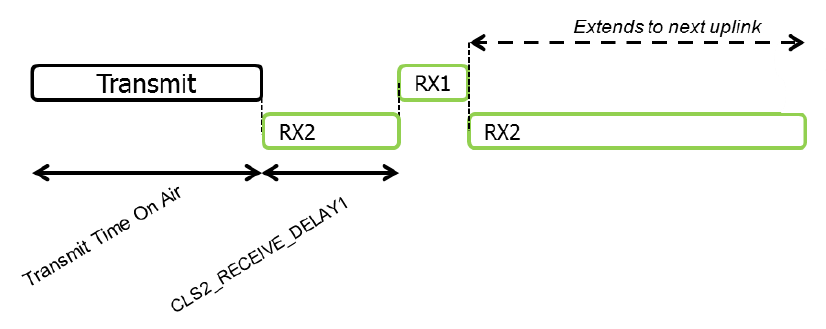Problem
Hi, we are facing an issue when sending downlink packets within 2 seconds of an uplink message. The system is trying to downlink a packet on the RX2 frequency while the device is in its RX1 window. We are not sure if the issue stems from the LNS or Basicstation, but I will do my best to outline all logs and behavior to help steer this.
Environment
- MTC Conduit (fw version 5.3.0), running basicstation 2.0.5
- Chirpstack NS 3.12.1 3.12.2
- Chirpstack AS 3.14
- Chirpstack GB 3.10
- End device: mbed-os-lorawan node as class C
- No messages use ‘confirmed’
Reproduction
Generate a downlink packet with the LNS less than 2 seconds after an uplink has occurred. What we find is that the packet is sent with RX2 parameters, on the RX2 frequency, while the device is in its RX1 window. I’ll use the lorawan spec picture here to illustrate:
Supporting Logs
The timestamps were sync’d down to the millisecond, as seen by the RX event in the station logs and the Transmission completed in the device logs.
Basicstation Log
As you can see, station gets a downlink packet (line 4) about 1.5 seconds after an uplink occurs. It ends up scheduling and sending the packet with RX2
2021-03-23 14:44:55.329 [any:XDEB] RX mod=LORA f=902500000 bw=125 sz=43 dr=2 40B0F90001003600B6315AC9D1ED7962F702EF9560FD7C32A1259C8601EC01D0FC9EC0EDB29BD3E8102F21
2021-03-23 14:44:55.329 [S2E:VERB] RX 902.5MHz DR3 SF7/BW125 snr=10.2 rssi=-29 xtime=0xA00001D1E0453 - updf mhdr=40 DevAddr=0100F9B0 FCtrl=00 FCnt=54 FOpts=[] B6315AC9..9BD3 mic=556732648 (43 bytes)
2021-03-23 14:44:55.330 [AIO:XDEB] [4|WS] > {"msgtype":"updf","MHdr":64,"DevAddr":16841136,"FCtrl":0,"FCnt":54,"FOpts":"","FPort":182,"FRMPayload":"315AC9D1ED7962F702EF9560FD7C32A1259C8601EC01D0FC9EC0EDB29BD3","MIC":556732648,"RefTime":0.000000,"DR":3,"Freq":902500000,"upinfo":{"rctx":0,"xtime":2814750255613011,"gpstime":0,"fts":-1,"rssi":-29,"snr":10.25,"rxtime":1616510695.330084}}
2021-03-23 14:44:56.936 [AIO:XDEB] [4|WS] < {"msgtype":"dnmsg","DevEui":"01-01-01-01-01-01-01-01","dC":2,"diid":7771,"pdu":"60b0f90001002800b48d8c0d191c6d","priority":1,"RX2DR":10,"RX2Freq":923300000,"xtime":2814750255613011,"rctx":0}
2021-03-23 14:44:56.936 [S2E:WARN] RxDelay mapped to 1 as it was not present!
2021-03-23 14:44:56.936 [S2E:VERB] 101:101:101:101 diid=7771 [ant#0] - starting TX in 49ms769us
2021-03-23 14:44:57.008 [any:XDEB] TX STATUS: 0x00000004
2021-03-23 14:44:57.008 [AIO:XDEB] [4|WS] > {"msgtype":"dntxed","seqno":7771,"diid":7771,"DR":10,"Freq":923300000,"DevEui":"01-01-01-01-01-01-01-01","rctx":0,"xtime":2814750257280904,"txtime":676.119413,"gpstime":0}
2021-03-23 14:44:57.008 [S2E:INFO] TX 101:101:101:101 diid=7771 [ant#0] - dntxed: 923.3MHz 30.0dBm ant#0(0) DR10 SF10/BW500 frame=60B0F90001002800B48D8C0D191C6D
2021-03-23 14:44:57.058 [S2E:DEBU] Tx done diid=7771
Device Log
Shows the timing of the Class C device of when it opens its windows. Looks normal for recv_delay of 1s
[03-23-21 14:44:55.329] [DBG ][LSTK]: Transmission completed
[03-23-21 14:44:55.329] [DBG ][LMAC]: RX2 slot open, Freq = 923300000
[03-23-21 14:44:56.294] [DBG ][LMAC]: RX1 slot open, Freq = 923900000
[03-23-21 14:44:57.317] [DBG ][LMAC]: RX2 slot open, Freq = 923300000
Questions
- Who should decide which window to target based on the dnmsg seen here?
- Looking at the downlink message protocol here, it has two types:
" A Class C downlink frame which answers an uplink and is aimed at RX1"
" A Class C downlink frame not answering an uplink"
I am not sure what that means really, but it doesn’t matter if it is “answering” or not. If a completely unsolicited message happens to occur during this time it will exhibit the same behavior, whether its an “answer” or not. I do notice that in our example the LNS does NOT send RX1DR/RX1Freq in the dnmsg, perhaps it should? - It further goes on to say “The transmission will be delayed until the Station finds a convenient time slot”, indicating the Station should be aware of what RX window the device is in, and should have delayed the transmission in the above case?

